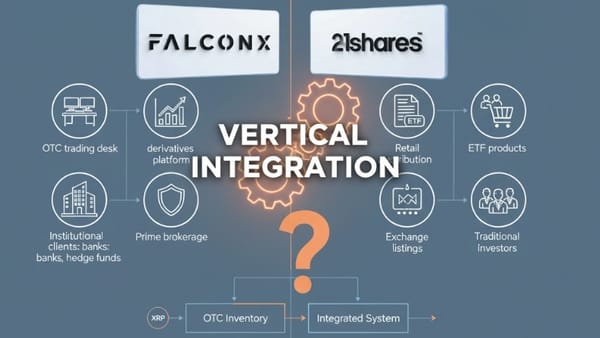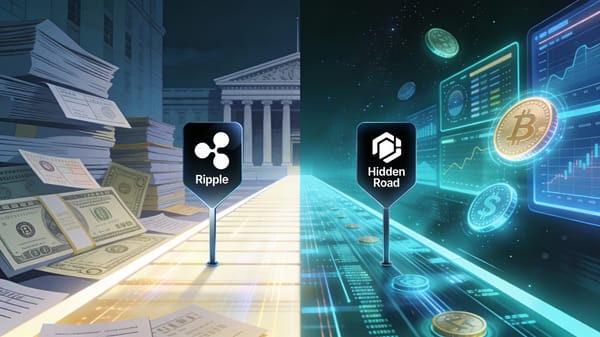SWIFT Under Siege: How Web3 Could Transform Global Finance
SWIFT's 50-year dominance faces its biggest challenge yet. Blockchain networks promise instant, cheap global payments while CBDCs and XRP vie to revolutionize cross-border finance. Discover how Web3 could transform money movement for everyone.

The global financial infrastructure faces its biggest disruption in 50 years. SWIFT, the Society for Worldwide Interbank Financial Telecommunications that connects over 11,000 institutions across 200+ countries, finds itself challenged by emerging Web3 technologies that promise faster, cheaper, and more transparent cross-border payments.
What is SWIFT and Why Does It Matter?
SWIFT is a messaging network that enables banks to communicate payment instructions for international transfers. Founded in Brussels in 1973, SWIFT replaced the slower, less secure TELEX system and helped standardize global payments. Crucially, SWIFT doesn't actually move money—it sends secure payment orders between financial institutions.
SWIFT's Impact on Everyday Life
For consumers and businesses, SWIFT powers nearly every international transaction:
- International wire transfers: When you send money abroad, it likely travels through SWIFT's network
- Business payments: Companies rely on SWIFT for supplier payments and international commerce
- Trade finance: 44.8 million FIN messages per day are sent via the SWIFT system supporting global trade
- Currency exchange: SWIFT facilitates the $150 trillion in annual cross-border transactions
However, SWIFT comes with significant limitations. SWIFT has a reported error rate of 6%, with some Fortune 50 companies experiencing an 11% failure rate in cross-border transactions. Traditional SWIFT transfers can take 1-5 business days and involve multiple fees from intermediary banks.
The Web3 Revolution: Blockchain-Powered Alternatives
Web3 technologies are fundamentally reimagining how money moves across borders. Unlike SWIFT's hub-and-spoke model requiring correspondent banks, blockchain networks enable direct peer-to-peer transfers.
Key Advantages of Blockchain Payments
Speed: Near-instant settlement times (seconds instead of days) compared to SWIFT's multi-day processing.
Cost: By eliminating intermediaries, blockchain-based payment systems can potentially reduce transaction costs, increase efficiency, and improve security.
Transparency: Blockchain technology provides a transparent and tamper-proof record of all transactions, allowing both sender and recipient to track payments in real-time.
Global Reach: Blockchain technology is a decentralized system, which means that it is not tied to any specific country or jurisdiction, enabling truly borderless payments.
Leading Web3 Payment Solutions
Central Bank Digital Currencies (CBDCs): 134 countries are currently exploring CBDCs, with projects like mBridge enabling direct cross-border payments between central banks without SWIFT intermediation.
Stablecoins: Standard Chartered's Hong Kong division announced a joint venture with Animoca Brands and HKT to issue a Hong Kong dollar-backed stablecoin for enhanced cross-border payments.
Enterprise Blockchain Networks: Vottun has collaborated with the Bank of Spain to develop a solution that uses blockchain technology as infrastructure instead of the traditional SWIFT banking system, enabling multinational companies to reduce time and costs for cross-border transfers.
XRP/Ripple: The SWIFT Challenger
Ripple and its native token XRP represent the most direct challenge to SWIFT's dominance. XRP is positioned as a scalable, low-cost alternative to SWIFT, which facilitates over $150 trillion annually in global financial transactions.
XRP's Value Proposition
Instant Settlement: Unlike SWIFT, which relies on pre-funded accounts and slow, multi-day settlements, XRP provides instant, cost-efficient cross-border payments.
Cost Efficiency: With transaction costs typically measured in fractions of a cent, the XRPL is one of the most cost-efficient networks among the top three blockchains by market capitalization.
Enterprise Adoption: XRP now plays a vital role behind the scenes in powering Ripple's ODL service, which enables fast, low-cost cross-border payments without the need for pre-funded accounts.
Market Projections and Reality
Speaking at the XRP APEX 2025 event in Singapore, Ripple CEO Brad Garlinghouse shared a bold projection: XRP could capture 14% of SWIFT's volume over the next five years. However, Garlinghouse has made it clear that Ripple is not partnering with SWIFT but instead aims to replace it.
Recent speculation about SWIFT-Ripple integration has intensified, with new estimates suggesting XRP could potentially process up to 20% of SWIFT's transactional volume, which would translate to approximately $30 trillion in annual value.
Real-World Implementation
XRP is already gaining traction in specific corridors:
- UnionBank became the first fully licensed virtual-asset bank in the Philippines and has integrated RippleNet and ODL to support faster cross-border payments
- ChinaBank, in partnership with Qatar National Bank (QNB), enables XRP-backed transfers from Qatar to the Philippines
SWIFT's Counter-Revolution
SWIFT isn't standing idle. The organization is actively modernizing its infrastructure:
Digital Asset Integration: Central and commercial banks will be able to use the Swift network to carry out trial transactions of digital currencies and assets, in expansive pilots that seek to demonstrate the cooperative's ability to facilitate the flow of all kinds of value.
Technology Partnerships: SWIFT has teamed up with Chainlink to improve its infrastructure, taking advantage of Chainlink's Cross-Chain Interoperability Protocol (CCIP) for transfers of tokenized assets across multiple blockchains.
Enhanced Standards: Over one million ISO 20022 messages are now exchanged daily, across 150 sending and 220 receiving countries, reflecting a truly global shift toward richer data standards.
What a Web3 Revolution Would Mean for Everyone
For Consumers
- Instant international transfers: Money moving in seconds rather than days
- Lower fees: Elimination of correspondent banking charges
- 24/7 availability: No banking hour restrictions
- Greater transparency: Real-time tracking of all payments
For Businesses
- Improved cash flow: Instant settlement reduces working capital requirements
- Reduced operational costs: Fewer intermediaries mean lower transaction fees
- Enhanced global reach: Direct access to emerging markets without banking partnerships
- Programmable payments: Smart contracts enabling automated business logic
For Financial Institutions
- Reduced infrastructure costs: Less need for correspondent banking relationships
- New revenue streams: Opportunities in DeFi and tokenized assets
- Enhanced compliance: Automated reporting and transparent audit trails
- Competitive advantage: Faster, cheaper services for clients
Regulatory and Compliance Considerations
The transition won't be without challenges. SWIFT is subject to the laws of Belgium and the European Union, and when the EU imposes sanctions, SWIFT may be required to restrict access for those financial institutions. Web3 solutions must navigate complex regulatory frameworks while maintaining compliance with AML/KYC requirements.
CBDCs can provide a regulated and compliant environment for cross-border payments, while public blockchains can offer a more permissionless and decentralized alternative.
The Road Ahead: Coexistence or Competition?
Instead of complete replacement, we will see a period of coexistence, as businesses try and test methods that make the most sense for them. Different solutions will likely serve different market segments:
- SWIFT: Maintaining dominance in traditional banking and high-value institutional transfers
- CBDCs: Serving government-backed, regulated cross-border payments
- Blockchain networks: Powering instant, low-value transfers and emerging market access
- Hybrid solutions: Combining traditional rails with blockchain efficiency
A New Financial Dawn
The global payments landscape stands at an inflection point. While SWIFT has served the world well for nearly 50 years, Web3 technologies offer compelling advantages that could reshape international finance. The winners will be those who can deliver faster, cheaper, and more transparent payment experiences—whether through evolved traditional systems or revolutionary blockchain networks.
For consumers and businesses, this evolution promises a future where moving money internationally becomes as simple as sending an email. The question isn't whether change will come, but how quickly the financial world will adapt to this new paradigm.
DISCLAIMER: This newsletter is for informational purposes only and does not constitute investment advice or a recommendation to buy, sell, or hold any securities. Investments in cryptocurrencies or other financial assets carry significant risks, including the potential for total loss, extreme volatility, and regulatory uncertainty. Past performance is not indicative of future results. Always consult a qualified financial professional and conduct thorough research before making any investment decisions.
Sources
- SWIFT Official Website - https://www.swift.com/
- Invoiced SWIFT System Guide - https://www.invoiced.com/resources/blog/swift-banking-system
- SWIFT Digital Asset Trials Press Release - https://www.swift.com/news-events/press-releases/global-banks-use-swift-trialling-live-digital-asset-transactions-2025
- Rippling SWIFT Payment Guide - https://www.rippling.com/blog/how-swift-payment-works
- Wise SWIFT Explanation - https://wise.com/us/blog/what-is-swift
- Papaya Global SWIFT Alternatives - https://www.papayaglobal.com/blog/8-alternatives-to-swift-for-cross-border-payments/
- BVNK SWIFT Alternatives Analysis - https://www.bvnk.com/blog/swift-alternatives
- LCX Cross-Border Payments Report - https://www.lcx.com/cross-border-payments-and-blockchain-technology/
- 21Shares XRP Analysis - https://www.21shares.com/en-us/blog/xrp-swift-on-the-blockchain
- Finance Magnates XRP Coverage - Multiple articles on XRP developments



